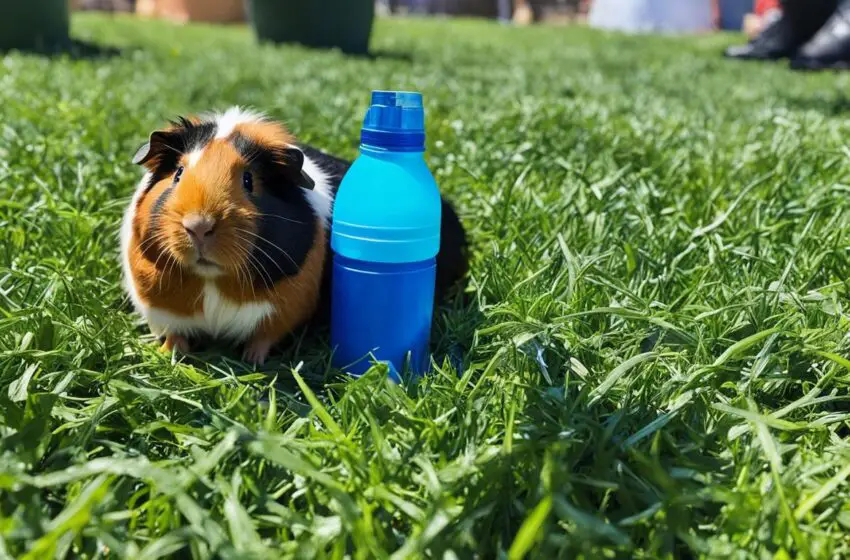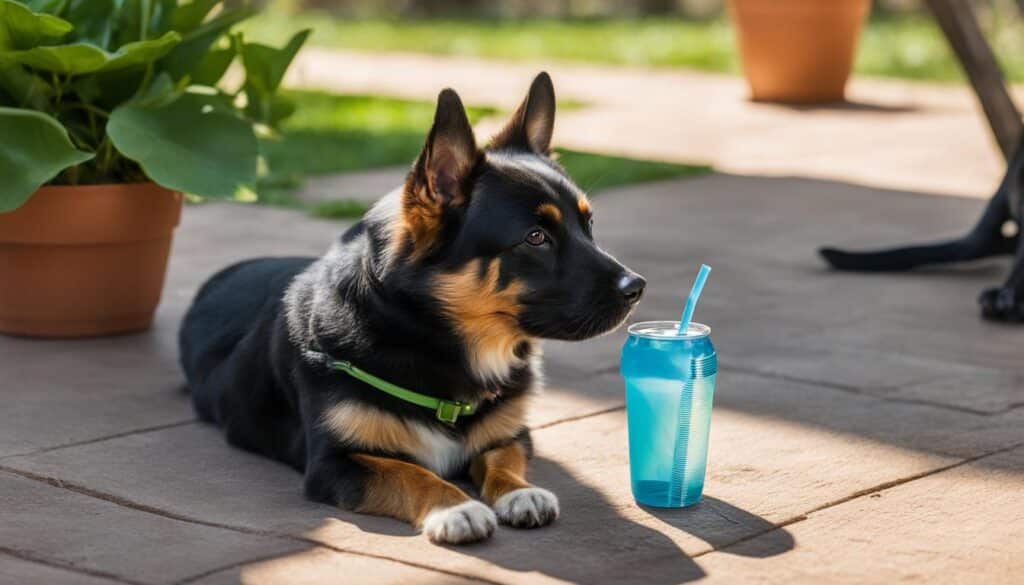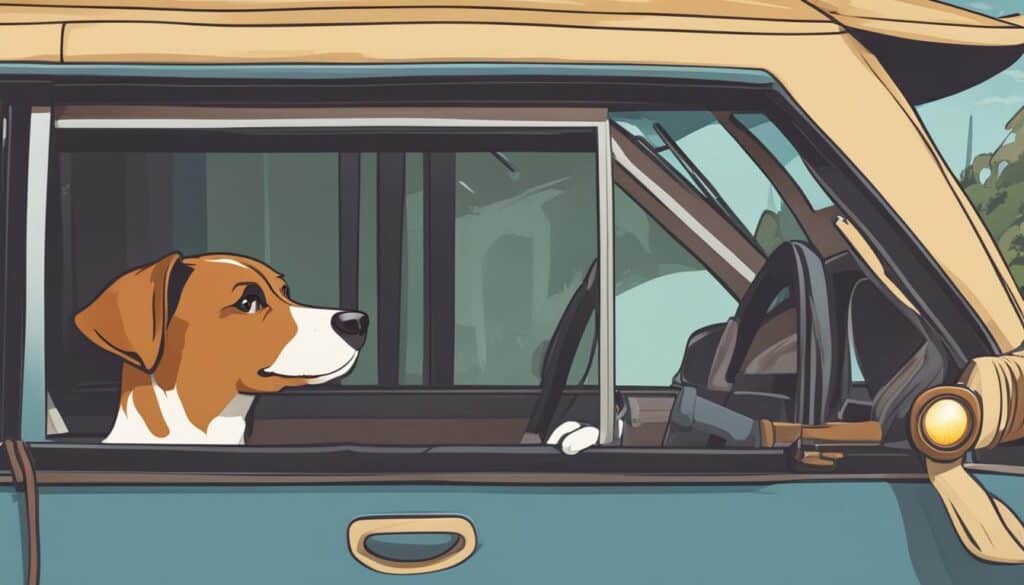Summer Heat Safety Tips for Small Pets

As temperatures rise during the summer months, it’s crucial to take precautions to protect our furry friends from the heat. Follow these essential tips to ensure the safety and well-being of your small pets.
Key Takeaways:
- Provide ample shade and fresh water for your small pets to keep them cool and hydrated.
- Avoid direct sun exposure and hot pavement, as they can cause heat-related issues.
- Never leave small pets in a parked car, as the temperature can quickly become dangerous.
- Be aware of the signs of heatstroke in small pets and take immediate action if necessary.
- Consider using cooling aids and offering pet-friendly ice treats to help your pets beat the heat.
Understanding the Risks of Summer Heat for Small Pets
Heat can pose significant dangers to small pets, making them more susceptible to heatstroke and dehydration. Unlike humans, small pets cannot regulate their body temperature as effectively, putting them at higher risk in hot weather. It is crucial for pet owners to comprehend these risks and take the necessary precautions to protect their furry companions.
Hot weather can lead to heatstroke in small animals, which is a potentially life-threatening condition. Heatstroke occurs when an animal’s body temperature rises dramatically and surpasses its ability to cool down. This can result in organ failure, brain damage, and even death if not promptly treated.
“Heatstroke can be a medical emergency requiring immediate veterinary care,” cautions Dr. Emily Thompson, a veterinarian with extensive experience in small animal medicine. “It’s essential for pet owners to recognize the signs of heatstroke and take swift action to prevent any life-threatening complications.”
Some common signs of heatstroke in small pets include:
- Excessive panting and difficulty breathing
- Excessive drooling and increased thirst
- Weakness, lethargy, and disorientation
- Rapid heart rate and elevated body temperature
- Vomiting and diarrhea
If you observe any of these symptoms in your small pet, it is crucial to act quickly. Move your pet to a shaded and cool area immediately, offer small amounts of water if they are conscious, and seek veterinary assistance without delay.
“The first steps in managing heatstroke involve reducing the pet’s body temperature,” explains Dr. Thompson. “However, it is crucial to remember that cooling them too rapidly can also be dangerous. It’s always best to consult with a veterinarian for proper guidance and supportive care.”
“Small pets, such as rabbits, hamsters, and guinea pigs, are particularly susceptible to the heat due to their small size and limited ability to cool down. It is our responsibility as pet owners to ensure their safety and well-being in hot weather conditions.”
To provide a comprehensive understanding of the dangers of heat for small pets, let’s examine the differences between humans and animals in terms of heat regulation. Take a look at the table below that highlights these distinctions:
| Humans | Small Pets | |
|---|---|---|
| Ability to Sweat | Humans have sweat glands throughout their bodies, which allows them to release heat and cool down efficiently. | Small pets have a limited ability to sweat, primarily relying on panting to dissipate heat. However, panting may not be as effective in extreme temperatures or high humidity. |
| Body Size and Surface Area | Compared to small pets, humans generally have a larger body size and greater surface area, which enables heat dissipation. | Small pets have a smaller body size and surface area relative to humans, making it more challenging for them to cool down and regulate body temperature. |
| Tolerance to Heat | Humans have a higher heat tolerance due to their sophisticated thermoregulatory systems. | Small pets have a lower heat tolerance and may experience heatstroke or other heat-related complications more quickly. |
This table illustrates the unique vulnerability of small pets to heat-related risks, emphasizing the need for vigilant care and preventive measures during the summer months.
In the next section, I will discuss proactive steps you can take to provide ample shade and fresh water for your small pets to help them stay cool and hydrated in hot weather.
Provide Ample Shade and Fresh Water
When it comes to keeping small pets cool during the summer, providing ample shade and fresh water is essential. By creating a cool and shaded area for your pets to escape the heat, you are ensuring their comfort and safety. Set up a sheltered space with proper ventilation, such as a covered porch or a shaded corner of your yard.
Not only should you provide shade, but you should also make sure that your small pets always have access to fresh, cool water. Keep their water bowls filled throughout the day and replace the water regularly to prevent it from becoming too warm. Consider using ice packs or frozen water bottles in the water bowl to help keep it cool for longer periods.
Remember, small pets can easily become dehydrated in hot weather, so it’s crucial to monitor their water intake and refill their bowls as needed. Pay attention to any changes in their drinking habits, as increased thirst could be a sign of dehydration.

“Creating a cool and shaded area for small pets and ensuring they have access to fresh, cool water are essential for their well-being in the summer heat.”
How to Create a Shaded Area for Your Small Pets
To provide adequate shade for your small pets, consider the following:
- Place pet-friendly umbrellas or canopies in their outdoor play areas or enclosures to shield them from direct sunlight.
- Set up a small tent or portable shade structure in your backyard where your pets can relax and cool down.
- Position their cages or enclosures under trees or near shaded areas in your home.
Keeping Water Cool and Refreshing
To ensure your small pets have access to cool and refreshing water:
- Regularly check the water temperature and replace it with fresh, cool water when necessary.
- Place their water bowls in shaded areas to prevent the water from heating up quickly.
- Add ice cubes or frozen fruits to their water bowls, providing an extra source of hydration and a refreshing treat.
| Signs of Dehydration in Small Pets | Preventive Measures for Keeping Pets Hydrated |
|---|---|
| Excessive panting | Monitor water intake and refill bowls regularly |
| Lethargy or decreased activity | Add ice cubes to the water bowl to encourage drinking |
| Dry or sticky gums | Provide multiple water bowls in different shaded areas |
| Loss of appetite | Consider using pet water fountains that keep water circulating and cool |
Avoid Direct Sun Exposure and Hot Pavement
When it comes to protecting small pets from the sun, limiting their exposure to direct sunlight is crucial. Direct sunlight can quickly raise the temperature and lead to overheating in small pets. Especially during the hottest parts of the day, it’s important to ensure that your furry friends have access to shaded areas where they can escape the sun’s harsh rays.
Additionally, hot pavement can pose a serious risk to your pet’s paws. Asphalt and concrete can absorb and retain heat, making them extremely hot and potentially burning their sensitive paw pads. To prevent any injuries, it’s best to avoid walking your pet on hot pavement, especially during the peak hours of the day.
If you need to take your small pet for a walk, opt for cooler times of the day or choose grassy areas where the ground temperature is less likely to be excessively hot. This way, you can protect their paws from potential burns and keep them comfortable throughout your outdoor activities.
Importance of Protecting Small Pets from the Sun
Excessive sun exposure can cause heatstroke, sunburn, and dehydration in small pets. By taking preventive measures and avoiding direct sun exposure, you can keep them safe and healthy.
| Protective Measures | Benefits |
|---|---|
| Providing shaded areas | Prevents overheating |
| Avoiding hot pavement | Protects paw pads from burns |
| Choosing cooler times for outdoor activities | Reduces the risk of heat-related illnesses |
Never Leave Pets in a Parked Car
Leaving your small pets in a parked car, even for a short period of time, can be extremely dangerous. The temperature inside a car can rise rapidly, reaching deadly levels within minutes. As a responsible pet owner, it is essential to prioritize their safety and well-being by never leaving them unattended in a hot car.
The interior of a car can quickly turn into a scorching oven, even on a relatively mild day. According to the American Veterinary Medical Association, the temperature inside a parked car can increase by 20 degrees Fahrenheit (11 degrees Celsius) in just 10 minutes, and continue to rise thereafter. This rapid increase in temperature can put your small pets at risk of heatstroke, dehydration, and even death.
Many pet owners underestimate how quickly a car can become dangerously hot, leading to potentially fatal consequences for their furry companions. It is crucial to remember that cracking the windows or parking in the shade does not effectively reduce the temperature inside the vehicle. The heat can still become overwhelming, putting your pet’s life in grave danger.
When running errands or traveling with your small pets, there are safer alternatives to leaving them in the car. Always bring them with you, ensuring they have access to a cool and comfortable environment. If you know you will be unable to supervise them or keep them cool, consider leaving them at home where they are safe from the dangers of extreme heat.
By taking this simple precaution, you can protect your pets from the hazards of a hot car and ensure their well-being. Remember that they rely on you for their safety, so be a responsible pet owner and never leave them unattended in a parked car.
Together, let’s prioritize the safety and happiness of our small pets in the summer heat.
“Leaving a pet unattended in a parked car, even with windows cracked, can lead to heat stress, organ damage, and death within a matter of minutes.”
– Dr. Eric Davis, Veterinary Specialist

| Time | Interior Car Temperature | Estimated Risk |
|---|---|---|
| 10 minutes | 20ºF (11ºC) increase | Risk of heatstroke |
| 30 minutes | 34ºF (19ºC) increase | Life-threatening conditions |
| 60 minutes | 43ºF (24ºC) increase | Lethal to pets |
Watch for Signs of Heatstroke
It’s important to be able to recognize the symptoms of heatstroke in small pets to ensure their well-being. The signs may include:
- Excessive panting
- Drooling
- Lethargy
- Rapid heartbeat
- Vomiting
- Collapse
If you notice any of these signs, it’s crucial to act quickly. Move your pet to a cooler area, offer them water to drink, and seek veterinary attention immediately. Heatstroke can be life-threatening, so it’s important to take immediate action to cool your pet down and seek professional help.
It’s important to remember that prevention is key in avoiding heatstroke. By following the safety tips and precautions discussed in this article, you can help protect your small pets from the dangers of overheating.
Consider Cooling Aids and Pet-Friendly Ice Treats
When it comes to helping your small pets beat the summer heat, there are various cooling options and refreshing treats you can provide. Here are some ideas to keep your furry friends cool and comfortable:
1. Pet-Safe Cooling Mats
Invest in a pet-safe cooling mat to provide your small pets with a comfortable and cool surface to rest on. These mats are designed to absorb and dissipate heat, offering a soothing spot for your pets to relax during hot days.
2. Cooling Fans
Consider using cooling fans specifically designed for pets. These fans circulate the air and provide a gentle breeze to help cool down your small pets. Place the fan strategically in the room or area where your pets spend most of their time.
3. Misting Systems
Set up a pet-friendly misting system in your outdoor space to keep the surroundings cool. The gentle mist can provide relief from the heat for your small pets and create a refreshing environment for them to enjoy.
4. Homemade Ice Treats
Prepare simple and refreshing ice treats for your pets using pet-friendly ingredients. Freeze small pieces of fruits, like watermelon or berries, to create fruity popsicles. You can also freeze low-sodium broth in ice cube trays for a savory and hydrating treat.
Remember to always supervise your pets while they enjoy these ice treats to avoid any choking hazards.
“Help your small pets beat the summer heat with a variety of cooling aids and pet-friendly ice treats.”
By providing cooling aids and delicious ice treats, you can ensure that your small pets stay comfortable and hydrated during the hot summer months.
Conclusion
Protecting your small pets in high temperatures is essential for their safety and well-being during the summer heat. By following these summer heat safety tips, you can ensure that your furry companions stay cool, comfortable, and healthy.
First and foremost, provide ample shade and fresh water for your pets. Creating a shaded area with proper ventilation and supplying cool, refreshing water will help them stay hydrated and regulate their body temperature.
Additionally, always avoid direct sun exposure and hot pavement. Limit your pets’ time outside during the hottest parts of the day and opt for grassy areas when walking them to prevent their paws from burning.
Never leave your pets in a parked car, even for a short period. The temperature inside a car can rise to dangerous levels rapidly, leading to heatstroke and potentially fatal consequences. Always bring them with you or leave them in a cool environment at home.
Watch for signs of heatstroke, such as excessive panting, drooling, lethargy, and vomiting. If you notice these symptoms, move your pets to a cooler area, offer them water, and seek veterinary attention immediately.
Finally, consider using cooling aids such as pet-safe mats, fans, or ice treats to help your small pets stay cool and comfortable.
With these precautions in place, you can enjoy the summer while ensuring the well-being of your beloved small pets. Stay vigilant and prioritize their safety so that they can have a happy and healthy summer!
FAQ
Why is heat dangerous for small pets?
Heat can be especially dangerous for small pets, who are more susceptible to heatstroke and dehydration. Unlike humans, they cannot regulate their body temperature as effectively.
How can I keep my small pets cool in the summer?
Create a cool and shaded area for your small pets to escape the heat. Set up a sheltered space with proper ventilation and provide plenty of fresh, cool water at all times. Consider using ice packs or frozen water bottles to keep the water cool for longer periods.
How can I protect my small pets from the sun?
Direct sunlight can quickly raise the temperature and cause overheating in small pets. Limit their exposure to the sun, especially during the hottest parts of the day. Additionally, be mindful of hot pavement, as it can burn their paws. Opt for walks during cooler times of the day or on grassy areas.
Is it safe to leave my small pets in a parked car?
No, it is never safe to leave your small pets in a parked car, even for a short period of time. The temperature inside a car can rise rapidly, reaching deadly levels within minutes. Always bring them with you or leave them at home where they can be in a cool and comfortable environment.
What are the signs of heatstroke in small pets?
Signs of heatstroke in small pets may include excessive panting, drooling, lethargy, rapid heartbeat, vomiting, and collapse. If you suspect heatstroke, move them to a cooler area, offer water to drink, and seek veterinary attention immediately.
What cooling aids can I provide for my small pets?
Help your small pets stay cool by providing them with cooling aids such as pet-safe cooling mats, fans, or misting systems. You can also prepare homemade ice treats using pet-friendly ingredients like frozen fruits or low-sodium broth. Always supervise your pets when offering these treats.
How can I ensure the safety of my small pets during summer heat?
With the proper precautions and awareness, you can keep your small pets safe and comfortable during the summer heat. Remember to provide shade, fresh water, and never leave them in a parked car. Watch for signs of heatstroke and offer cooling aids when needed. By prioritizing their well-being, you can ensure a happy and healthy summer for your beloved furry companions.



